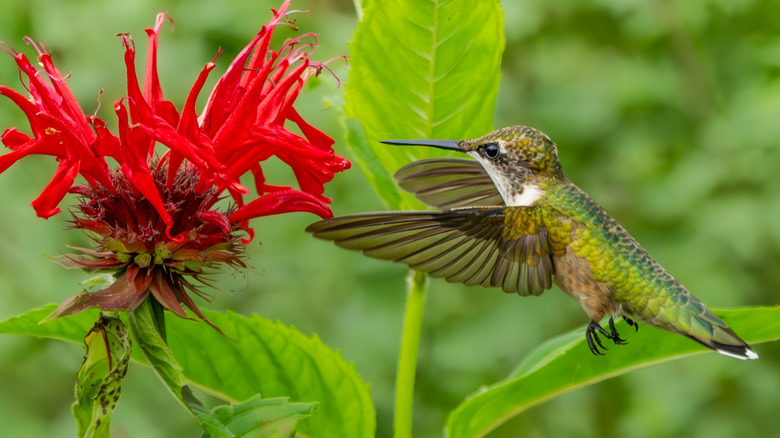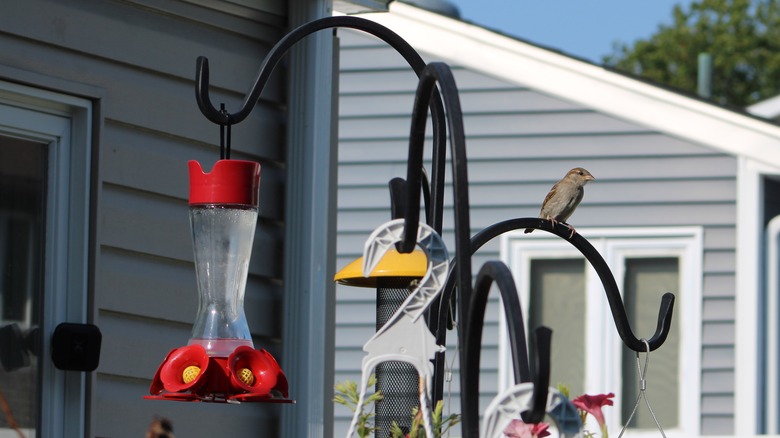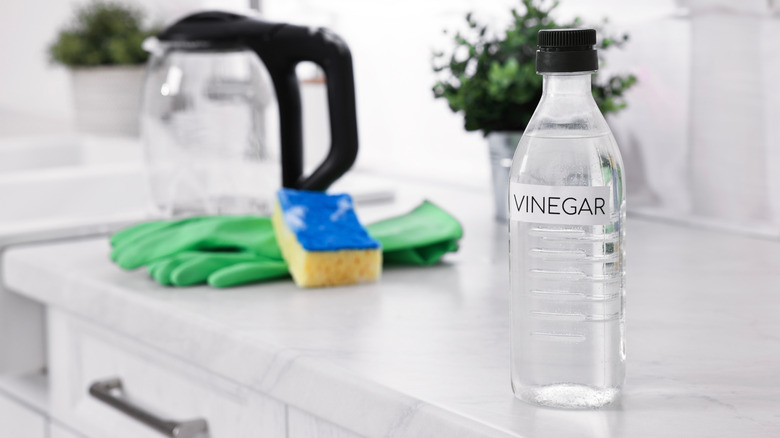Can You Use A Bird Feeder To Attract Hummingbirds To Your Yard?
You may put out all types of bird seed to attract your favorite birds to your yard, but what about attracting hummingbirds? Can you use a bird feeder to entice them? Simply put, no. Hummingbirds don't regularly eat out of a typical bird feeder stocked with seed and nuts, as these aren't typically part of their diet, though you may occasionally spot a hummer checking out feeders if hungry enough. Instead, they dine from nectar feeders. While they may eat insects like other birds, hummingbirds heavily prefer flower nectar. In fact, they consume large amounts, eating up to 80% of their body mass daily. They may eat pollen accidentally, but it's the sugary nectar that keeps those tiny wings beating over 700 times a minute. So while seed isn't on their menu, you can use a nectar station to welcome these beloved colorful birds.
Hummingbird feeders are available at most garden stores and feature a special design meant for dispensing nectar or, more often, sugar water. There are two main style options for nectar stations. These are the saucer feeder and the reservoir style, though both types are often red to attract hummer attention. The saucer is a slim dish that holds nectar, with its low design good for keeping bees or wasps out. The reservoir, however, uses an inverted container to hold the nectar, dispensing it through feeding ports. Some hummingbirds are surprisingly particular, so you may find they choose one feeder type over another. Regardless of which style you use, you must ensure you stock it with the correct nectar mixture and place it in an area where hummingbirds are likely to visit.
Attracting hummingbirds with a feeder
Setting up your feeder begins with the sweet nectar they adore. You can buy nectar, but homemade hummingbird nectar is surprisingly easy to make and can be safer. Boil ¼ cup of refined white sugar with 1 cup of water. After it cools, add it to the feeder, and store any extra in the fridge. Never use any other sugar, including brown sugar or honey, to feed hummingbirds. Among the other things you should never add to your hummingbird nectar are artificial sweeteners, red dye, and Kool-Aid.
After your hummingbird feeder is appropriately stocked, you're ready to hang it in your garden or yard. It's best to keep your nectar station located 4 to 6 feet off the ground. With the feeder set at this height, it's easy for the birds to spot and gives them the best vantage point for scanning for predators. Place it in an area with some shade, as direct sunlight can quickly spoil nectar.
For the best results, locate your feeder near nectar-rich flowers, ideally tubular-shaped in red and orange shades. Use a combination of flowers like scarlet sage (Salvia coccinea) and bee balm (Monarda didyma) along with coral honeysuckle (Lonicera sempervirens). Filling your yard with their preferred nectar sources makes it so that not only do hummingbirds visit, but they can also see your feeder while visiting blooms on their daily route. When you create a garden welcoming to hummers, you also invite visits from pollinators like bees and butterflies.
How to properly care for and clean your hummingbird feeder
Maintaining cleanliness is essential when using a nectar feeder to attract hummingbirds, or else you may sicken them. Make a habit of cleaning your feeder every time the birds empty it, you spot insect activity, or see signs of mold growth. Cleaning also removes any leftover nectar or sugary residue that could attract pests. In the warmer months, periods marked by a lot of hummer activity, you should empty and clean the feeder every day or at least every other day. The nectar or sugar water can spoil faster in the sunlight, so stay proactive to keep your feeder healthy. As the weather cools, you can typically clean it twice a week.
The best approach is to dissemble the feeder, if possible, and then use hot water and a brush to scrub away any dried leftover nectar. Never use any dish soap or abrasive chemicals to clean the feeder, as these can leave behind residue. You can use bleach and water, with 1 part bleach to 9 parts water, to fully remove any dried nectar. If there's mold or mildew present, soak the feeder's components in a diluted vinegar solution, with 2 parts water to 1 part vinegar. Never mix bleach and vinegar, as this can create toxic fumes. Regardless of what you clean the feeder with, always rinse it thoroughly with fresh water and let the feeder dry completely before refilling, as any trapped moisture can cause bacterial growth.


